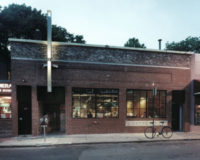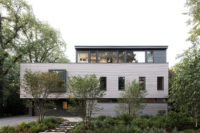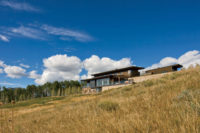Community Rowing, Inc. (CRI) is the largest rowing organization in the country, and fully 40 percent of the boats on Boston’s Charles River belong to the club. Yet until last fall, it had no place to call home. After operating seasonally out of the nearby Daly ice-skating rink for over 20 years, CRI has finally laid down its roots on the city’s edge with a 30,000-square-foot boathouse designed by Cambridge, Massachusetts—based Anmahian Winton Architects.
Additional Content:
Jump to credits & specifications
Program
The sleek Community Rowing Boathouse makes a bold statement on the banks of the Charles, where historic and historicist facilities dominate. Neither the client nor the architects were interested in reiterating this precedent. “We wanted the building to be of its time,” says principal Alex Anmahian, AIA. The unconventional approach is in line with the club’s mission. “There are a lot of elitist boathouses on the Charles,” continues Anmahian. “This one is like the YMCA of rowing — it’s open to everyone.” The nonprofit organization, founded in 1985 by individuals who rowed for renowned coach Harry Parker on the national team and at Harvard, welcomes the public and runs a number of recreational and competitive — as well as community-outreach — programs, and has outfitted the facilities for visually and physically challenged users.
The awkwardness of the city-owned, triangular, 3.5-acre site, previously used as a staging area for nearby infrastructure projects, posed challenges. The facility had to accommodate storage for over 170 boats and include a repair shop, training and locker rooms, administrative spaces, and classrooms. Additionally, the architects insisted on creating a public path along the riverbank, in contrast to other boathouses that tend to block the waterfront with broad ramps.
Solution
To house the large number of boats, Anmahian Winton split the facility into two separate volumes — one glass, one wood — rendering a court that visually and functionally connects the buildings to each other and the water. While most boathouses store boats perpendicular to the river, the architects oriented this project parallel to the water, allowing maximum efficiency in terms of boat storage (the 8-oar shells measure up to about 60 feet long) and minimal impact on the land. Budget constraints had forced the architects to abandon their vision for an all-glass main building, but created other opportunities.
For inspiration for the wood Community Rowing Boathouse, the architects looked to regional vernacular linear buildings, such as covered bridges and tobacco sheds. Tobacco sheds provided a particularly compelling model because sculls and shells, like tobacco leaves, need proper ventilation. This observation led the architects to the idea of a kinetic building. Eighteen-foot-tall bifolding vents clad in high-density composite panels with sustainably farmed ayous-wood veneer line the 200-foot-long bays, and are manually operated with a chain pull with gear reducers to admit light and air. Timber piles support the building’s steel moment frame, and boats are carried out through modified hangar doors at the east and west ends. “It’s really a warehouse with a special functionality about it,” notes Anmahian. Vertical cladding continues on the second floor. On the south, street-facing side the cladding takes the form of horizontal louvers to shade the building, mask mechanical vents, and shield locker-room clerestory windows.
The steel-framed Ruth W. Somerville Sculling Pavilion houses the smaller, one- and two-person sculls and shells. It realizes the original transparent scheme with 1⁄4-inch tempered-glass shingles fastened to the structure with aluminum clips. The pavilion, a vitrine for the streamlined fiberglass and carbon-fiber vessels within, admits light and facilitates natural ventilation while functioning as a billboard seen by cars zipping along the busy surface road and the Massachusetts Turnpike just beyond.
The team employed many sustainable features and approaches. In addition to the boat-storage bays, which are naturally ventilated, 50 percent of the second-floor window area is operable. The entire facility is heated and cooled with ground-source heat pumps supplied by a 1,500-foot-deep geothermal well. And by expanding the thermal comfort boundaries to 68 to 84 degrees from the typical 72 to 76, it was possible to reduce the size of the mechanical equipment. Extensive glazing provides direct sight lines to the outside for all occupants, and low-flow plumbing fixtures mitigate water consumption. Storm-water runoff is managed by a hardscape of permeable pavement and crushed stone, and bioretention swales recharge groundwater rather than directing rainwater into the river. A green roof will be installed once funding is secured, say the architects. The team did not seek LEED certification, notes Anmahian, citing the cost of the process.
Commentary
Aside from the bays, interiors are bland and basic, with a preponderance of dropped ceilings and drywall. Rowers’ focus lies outside, of course, and Anmahian explains that limited resources — $11.45 million for construction — were used where they would have the greatest civic impact. Indeed, Anmahian Winton has helped Community Rowing successfully transform a neglected patch of riverfront into the club’s calling card. The handsome new facility eschews nostalgic, Victorian pastiche and in a Modern language lifts the shroud of exclusivity from an age-old sport, bringing it down to earth and into the present day. With membership up 30 percent and youth-program participation up as much as 100 percent since the boathouse opened in October 2008, CRI is furthering its cause of making rowing, and the Charles River itself, accessible to all.
Location:
20 Nonantum Road, Boston, Massachusetts 02135
Completion Date:
October 2008
Gross square footage:
30,000 sq.ft.
Total construction cost:
$11.45M
PeopleOwner: The Resort Municipality of Whistler
Architect: Hughes Condon Marler Architects Personnel in architect's firm who should receive special credit: Alex Anmahian, AIA, Principal in Charge
Interior designer: Anmahian Winton Architects
Engineer(s): Civil Engineer: Marine Structural Engineer: Structural Engineer: MEP/FP Engineer:
Consultant(s): Landscape Architect: Lighting: Geothermal System: Sustainable Systems Analyst: Cladding Systems Fabricators: Envelope Consultants: Richard Keleher, AIA, 460 Powder Mill Road, Concord, MA 01742
General contractor: Consigli Construction Co., Inc.
Photographers: Mike Champion 51 Crawford Street, Watertown, MA 02472 Jane Messinger (617) 577-7400 Anmahian Winton Architects, 650 Cambridge Street, Cambridge, MA 02141 Peter Vanderwarker (617) 964-2728 32 Prince Street, West Newton, MA 02465 Sydney Schremser (617) 577-7400 Anmahian Winton Architects, 650 Cambridge Street, Cambridge, MA 02141
Renderer(s): Anmahian Winton Architects CAD system, project management, or other software used: Vectorworks 2008
|
ProductsStructural system: Mandate Erectors
Exterior cladding: Metal/glass curtainwall: Kawneer Wood: Prodema (fabricated by Extech Exterior Technologies)
Roofing: Other: American Hydrotech, Inc.
Windows: Aluminum: Schuco, Kawneer
Glazing: Glass: PPG, Oldcastle Glass Insulated-panel or plastic glazing: Centria
Doors: Entrances: Kawneer Metal doors: de la Fontaine Industries, Inc. Sliding doors: Schuco, Dorma Special doors (oversized swing doors below balconies): Custom fabricated by Extech Exterior Technologies Special doors (overhead door): Wayne Dalton/Moulton Custom Doors of Vermont Upward-acting bi-fold doors, other: Wilson Door Company
Hardware: Locksets: Von Duprin, Best Hinges: Rixon, Ives Closers: LCN, Rixon Exit devices: Ives, Von Duprin Pulls: Ives, Rockwood
Interior finishes: Acoustical ceilings: Ecophon Suspension grid: Armstrong Cabinetwork and custom woodwork: Fabrizio Woodworking Paints and stains: Tnemec, Sherwin Williams Special surfacing: Bituminous concrete (at Boat Storage Rooms) Floor and wall tile: Dal Tile (floors and walls at W/C and Shower Rooms)
Furnishings: Reception furniture: Custom fabricated by Bill Bancroft
Lighting: Interior ambient lighting: Bartco, Lightolier, Lithonia Downlights: Lightolier Task lighting: Alkco Exterior: Bega,BK Lighting
Plumbing: Water closets: Zurn Urinals: Toto (low consumption washout urinal) Lavatories: Toto, Elkay Faucets: Chicago Faucets, Elkay, Zurn Shower System: Symmons Utility Sinks: Fiat Drinking Fountains: Haws
|















Post a comment to this article
Report Abusive Comment